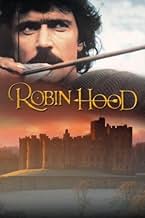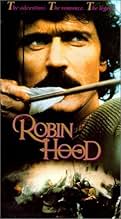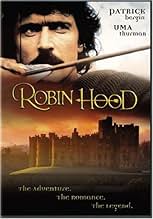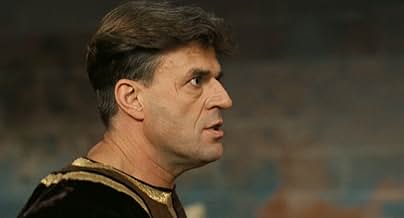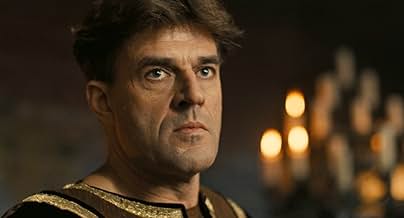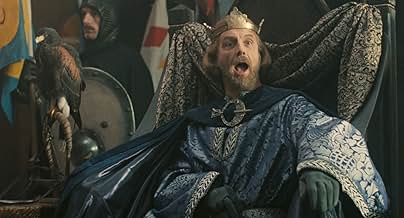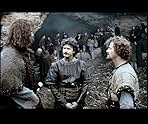अपनी भाषा में प्लॉट जोड़ेंThe Swashbuckling legend of Robin Hood unfolds in the 12th century when the mighty Normans ruled England with an iron fist.The Swashbuckling legend of Robin Hood unfolds in the 12th century when the mighty Normans ruled England with an iron fist.The Swashbuckling legend of Robin Hood unfolds in the 12th century when the mighty Normans ruled England with an iron fist.
- Much The Miller
- (as Daniel Webb)
- Sir Miles Folcanet
- (as Jurgen Prochnow)
- Baron Daguerre
- (as Jeroen Krabbe)
फ़ीचर्ड समीक्षाएं
ROBIN HOOD gets a lot more of the facts right but it's lacking as a decent piece of drama, mainly because the characters, although carefully depicted, are all rather unlikeable. That's particularly true of Patrick Bergin, whose Hood, all wild eyes and wilder hair, appears to be something of a sociopath instead of the folk hero of old; I just can't buy Bergin in good-guy roles, and that's the same here. Stick to SLEEPING WITH THE ENEMY, buddy.
The supporting actors are better, with one exception. Jurgen Prochnow is less hammy but no less amusing than Alan Rickman in the Costner version, and it's always good to see Jeroen Krabbe in Hollywood fare. Owen Teale, Danny Webb and David Morrissey are all good choices as Merry Men. The exception is Uma Thurman, who's terribly miscast as Marian; the scenes in which she disguises herself as a boy are excruciating.
Other than that, the script is overlong and underwritten and the action scenes just aren't very exciting. The sets and costumes are decent though, so it's just a shame that more effort couldn't have gone into making this a rousing swashbuckler of old. Instead it's a dour, uninspiring and ultimately forgettable version of a classic story.
1991 was the year which saw two films on the legend of Robin Hood. "Robin Hood: Prince of Thieves", a big-budget Hollywood blockbuster starring Kevin Costner, is by far the better-known of the two. This lower-budget version, simply entitled "Robin Hood", was only shown on television in the USA, although it was released in cinemas in other parts of the world. It did not feature any big Hollywood names; Uma Thurman may be a big name today, but in 1991 she was still more of an up- and-coming starlet.
As in "Prince of Thieves" and several other films on this subject, Robin is portrayed as a Saxon earl, here named Robert Hode. (The idea that Robin was an aristocrat was a later addition to the legend; the recent 2010 "Robin Hood" with Russell Crowe reverts to the original story by making him a Saxon of more humble origins). He falls foul of the authorities, and is declared an outlaw, when he intervenes to prevent a miller, who has been caught poaching the King's deer, from being blinded. He flees into Sherwood Forest, gathers together the "Merry Men", and fights for justice and the rights of the Saxon peasantry against the corrupt Norman nobility.
The film includes all the usual cast of Merry Men, including Little John, Will Scarlett, Friar Tuck and Much the Miller, as well as Maid Marian, but, oddly, not the normal villains. There is no Sheriff of Nottingham and no Sir Guy of Gisborne, and Prince John only puts in a brief appearance. (King Richard does not appear at all, although he is referred to). Instead, Robin's main antagonists are the Norman aristocrats Baron Roger Daguerre and Sir Miles Folcanet. (That is how it is spelt in the cast-list, although "Falconet" might be a more plausible French spelling). Sir Miles is a straightforward villain; it is he who wanted to have the unfortunate miller's eyes put out and he who is Robin's rival for Marian's hand. (She, of course, will have nothing to do with him). Daguerre, however, is a more ambiguous figure. He is Marian's uncle and originally Robin's friend; the two later fall out but are eventually reconciled, and Daguerre is converted to Robin's vision of an England where Saxon and Norman can live together in peace.
One similarity which links this film with the Russell Crowe version is that both aim at a more "naturalistic" view of the Middle Ages to the romanticised "Merrie England" view presented in the Errol Flynn classic "The Adventures of Robin Hood" from 1938 and, to some extent, in "Prince of Thieves". Some might think this sort of naturalism misplaced in a film which is based on legend rather than historical fact, but both directors (John Irvin here and Ridley Scott in 2010) clearly felt that a film dealing with a peasant revolt against oppression should show us something of the conditions against which the peasants are revolting. Mediaeval life is therefore portrayed as drab, dirty and dangerous, not as something colourful and exciting. The look of the film is dark with muted colours; the leafless trees in Sherwood Forest suggest that the story takes place in winter and early spring.
Patrick Bergin makes a charismatic hero, but few of the other characters, Thurman included, make the same impression. There is nothing particularly wrong with the performances of Jeroen Krabbé as Daguerre or Jürgen Prochnow as Folcanet, but neither of them makes as memorable a villain as Basil Rathbone's Gisborne in "The Adventures of Robin Hood" or Alan Rickman's Sheriff of Nottingham in "Prince of Thieves". Another weakness is it that lacks any real exciting or swashbuckling action sequences; not even the final attack on Nottingham Castle really counts as such. The climactic duel between Robin and Folcanet is in nothing like the same class as that between Flynn and Rathbone.
This "Robin Hood" is certainly better than "Robin and Marian" from the seventies, which manages to be both dull and unrealistic, but I would not rate it as highly as either the 2010 version or "Prince of Thieves", both of which could generate greater excitement. As for "The Adventures of Robin Hood", that set a very high standard, and in my view none of the versions since 1938 have really lived up to it. 6/10
क्या आपको पता है
- ट्रिवियाMade the same year as रॉबिन हुडः प्रिंस ऑफ़ थीव्स (1991) and thus did not receive a theatrical release in the United States.
- गूफ़Woad (the purple dye Robin throws at the tax-collector) wouldn't have been around in the middle of the village. The process used to make the dye smelled so bad that woad-makers had to live outside the village to make it. Also, while in the cauldron it actually looks green, the indigo/purple colour only shows up as you remove the dyed item from the liquid, so the dye would not have appeared purple in the bowl before Robin threw it.
- भाव
Maid Marian: So what are you going to do to me? Tie me up?
Robin Hood: Could be a lashing.
Maid Marian: How many strokes?
Robin Hood: As many as are necessary.
Maid Marian: And then it's finished?
Robin Hood: That depends. Have you ever been lashed before?
Maid Marian: I've never had someone make me beg them to stop.
Robin Hood: Then you've never had a proper lashing.
- इसके अलावा अन्य वर्जनMade for cinematic release but competition from रॉबिन हुडः प्रिंस ऑफ़ थीव्स (1991) ensured that it debuted on cable in the US (at 150 minutes) despite a cinema release elsewhere. USA videocassette version removes 34 minutes of footage.
टॉप पसंद
- How long is Robin Hood?Alexa द्वारा संचालित
विवरण
- रिलीज़ की तारीख़
- कंट्री ऑफ़ ओरिजिन
- भाषा
- इस रूप में भी जाना जाता है
- Робін Гуд
- फ़िल्माने की जगहें
- Peckforton Castle, Peckforton, Cheshire, इंग्लैंड, यूनाइटेड किंगडम(used as principle location)
- उत्पादन कंपनियां
- IMDbPro पर और कंपनी क्रेडिट देखें
बॉक्स ऑफ़िस
- बजट
- $1,50,00,000(अनुमानित)
- चलने की अवधि1 घंटा 44 मिनट
- रंग
- पक्ष अनुपात
- 1.85 : 1
इस पेज में योगदान दें



